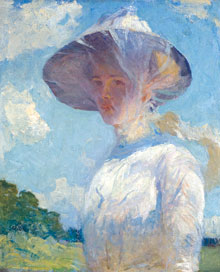
‘STUDY OF YOUNG GIRL WITH A VEIL’ A standard-setting piece by Frank Benson. |
The connections between Frank W. Benson (1862-1951) and Winslow Homer (1836-1910) and the Portland Art Society are pretty straightforward. The link between them and Frederic Edwin Church (1826-1900) is more subtle but important in its implications. Benson and Homer, of overlapping generations, both knew the Society. Homer was slightly younger than Church, but occupied a different conceptual generation.Three shows, "The Portland Society of Art: Homer's Legacy in Maine" and "Maine Sublime: Frederic Edwin Church's Landscapes of Mount Desert and Mount Katahdin" at the Portland Museum and "Impressionist Summers: Frank W. Benson's North Haven" at the Farnsworth Art Museum in Rockland are concurrent no doubt by chance rather than design. But taken together they shed some significant light on artistic thinking from the mid-19th century well into the 20th, as well as on the art audience and its expectations, and on the art market. Homer, Church, and Benson were successful in their lifetimes and command high prices today.
The Portland Society of Art was founded in 1882 and was the precursor to both the Portland Museum of Art and the Portland School of Art, later the Maine College of Art. That was about the time that the Homer family was settling into Prouts Neck in Scarborough, and the architect John Calvin Stevens was designing a family compound for them that included Homer's studio, now part of the museum. Stevens also designed the original home of the Society. It was a small art world then, and Benson was part of it. He taught at the Society for a couple of years starting in 1886.
Church started coming to Maine on a regular basis in about 1850. He was part of the second generation of Hudson River School painters who were influenced by the German Romantics and by Emerson and Thoreau. Church had an extraordinary hand, a lust for grandeur, and family money. He traveled widely and made large, carefully detailed paintings that he put on dramatic public display. His five-by-ten-foot "Heart of the Andes" had people lined up around the block paying good money to see it.
Church and his contemporaries saw nature as a place to seek the divine. It was God's handiwork as a sublime setting where human activity was dwarfed by the grand vistas of creation. People in his paintings are largely inconsequential when measured against the vast natural world. He came to Maine repeatedly, usually to Mount Desert or to Katahdin, to make oil sketches and drawings. There are a dozen paintings, mostly small and made on-site, and about as many drawings in this gem of a show. Church can be overwhelming in his large, iconic works, but here he is personal and comfortable and yet still puts forth his sense of the ineffable.
Homer spent his early years as a illustrator, starting as an apprentice engraver. He didn't come into his own as an artist until he was sent off as a war correspondent with the Union army in the Civil War. His first real painting, "The Sharpshooter," is owned by the PMA, and, along with "Artists Sketching in the White Mountains," anchors this interesting show. The 15 paintings and works on paper in the show are set in context by works of artists associated with the Portland Society.